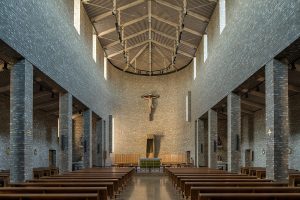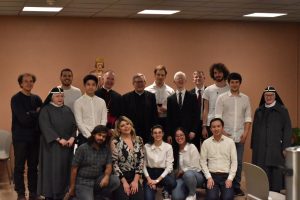Words on the Word
Dedication of the Cathedral
Ezekiel 47:1-12: Wherever the water flows, there is life and health.
1 Corinthians 3:9-17: We are God’s edifice.
John 2:13-22: Zeal for your house will devour me.
Our cathedral was dedicated on 19 November 2016. Many of you here were present then. You will remember the splendid rites of a wonderfully sensual ceremony. The liturgy makes it clear that a church is no simple assembly hall, but a sacred space filled with vibrating life, a space that is itself mystically alive.
The walls of the church are anointed with sacred chrism as if they were of flesh and blood. Fire is lit on the altar, a sign of purification but also of the Lord’s uncompromising call, for our God, remember, is consuming fire. The incense that fills the new church is a sign of the divine presence.
The choir sings, Terribilis locus iste. Insofar as we prefer religion light, purged of calories, we may be tempted to ditch this verse, for all its being prescribed in the missal, and instead sing a cheerful ditty about the pleasure of being together. We should resist that temptation. We need to hear, indeed to appropriate the trouble of the patriarch Jacob as he cried aloud at Bethel: ‘How terrible is this place! This is truly God’s house, the gate of heaven!’ It’s not for nothing that, on entering church, we fall on our knees. God is present here. Here, day after day, the sacrifice of Jesus for the saving of the world is accomplished. Here we touch eternity while, simultaneously, time becomes more compact. The presence of the Lord bids us, too, be fully present.
In church we ascertain: here I am!
The Catholic liturgy reminds us that things of this world point beyond themselves. It teaches us that humble substances like bread and wine, remaining themselves in form, can be invested with power from on high and thereby conform us to the life of God. As people of faith, we are constantly asked to recognise the bridge between visible and invisible realities, between what is of earth and what is of heaven. In looking, as it were, up and down at the same time, we approach the mystery of Christ, who was incarnate to ‘unite all thing in himself’; who, for being fully God, was fully a man, spreading abroad on this concrete, perspiring earth a fragrance of divinity.
In the Nicene Creed we profess belief in ‘one holy Catholic and Apostolic Church’. That Church is not a notional reality out there, a symbol floating in the ether. For spanning the world, it is present in fullness wherever the true faith is held, the sacraments validly celebrated, the faithful established in communion with the successors to the apostles. The bishop of Rome, the primal see of Christendom, is guarantor of this communion on a global scale. The same function is exercised locally by the bishop of each diocese, one in charity and faith with the See of Peter.
The bishop is not a roaming agent. He is linked to a particular group of people in a particular area, focused on a particular building. That building is the cathedral, so called because it contains the bishop’s cathedra, his ‘seat’, from which it is his duty to proclaim Christ’s Gospel authentically. As we commemorate the dedication of our own cathedral, let us rejoice that we are incorporated into the Church’s universal communion here.
Our rootedness in what is catholic finds concrete expression. By finding our place in the church locally, we live as members of the boundless Mystical Body, the sacrament of Christ. Here, in this place, we give expression to our love of Christ through the Church. Here we receive the grace which the Church administers. Here it is given us to serve the Church.
This explains why this commemoration is given such importance. This feast counts among the Feasts of the Lord. In our missal and breviary, the dedication liturgy is printed before the liturgy for feasts of the Mother of God. What we celebrate today is a christocentric mystery. We remember that a plot of land here in central Trondheim has been won for the kingdom of heaven.
Like Jacob we can see the contours of a ladder that, setting out from this room, unites eternity and time. Think of the words which the priest utters as part of the Eucharistic Prayer, while bowing low before the altar:
In humble prayer we ask you, almighty God: command that these gifts be borne by the hands of your holy angel to your altar on high in the sight of your divine majesty, so that all of us, who through this participation at the altar receive the most holy Body and Blood of your son, may be filled with every grace and heavenly blessing.
Heaven opens. Even as bread and wine are transformed, we are changed. We are called to enter the Lord’s house, not just to be given precious gifts, but in order to become a gift. The water Ezekiel saw in his vision, which rose from underneath the threshold of the temple to become a mighty river — this water God would distribute through us by letting us become part, here, of Christ’s oblation. The temple which the prophet saw, the Gospel tells us, was an image of Christ’s Body. Within that Body, and nowhere else, our life finds significance and purpose; we gain access to it here, in this holy place.
In a few moments, in the offertory prayer, the Church will place these words on my lips:
Lord, we recall the day on which you filled this house with your glory, and we pray: Make of us a sacrificial gift that is pleasing to you.
May the Lord open our eyes to behold the glory that surrounds us here; and may we never say No to what, here, he asks of us. Amen.


Living Stones.
